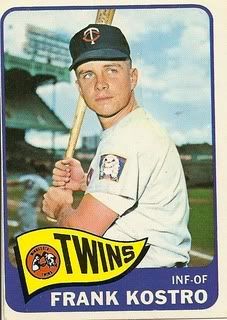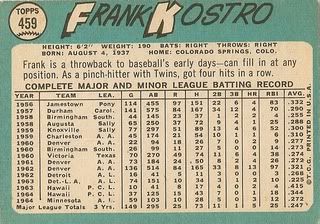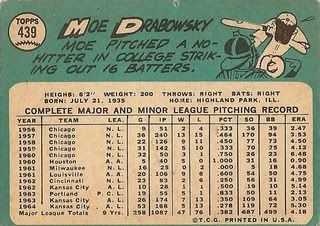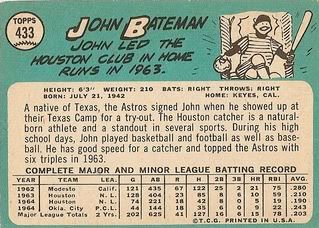
Fun facts about Frank Kostro:
-A native of Windber, PA, Frank signed with the Tigers in 1956 after attending Forbes High School in Pittsburgh.
-He spent parts of 13 seasons in the minor leagues and hit for average everywhere he went, posting a cumulative mark of .303. This apprenticeship includes six seasons with the Denver Bears, for whom he holds franchise records with 516 total hits and 101 doubles.
-Detroit gave Kostro a look in September 1962. The 24-year-old third baseman hit a pinch double off of Jim Kaat on September 7 for his first career hit.
-He split the 1963 season between the Tigers and Angels, batting .225 with a pair of home runs and 10 RBI in 151 at-bats. In addition to third base, he also played some first base, left field, and right field.
-Frank joined the Twins the following season and it was his most productive effort as a major leaguer: .272 with 3 homers and 12 RBI in 103 at-bats. He added second base to his defensive repertoire.
-He continued to ply his trade as a utility player in Minnesota until 1969, when he appeared in his last two big league games. In parts of seven seasons, he batted .244 with 5 home runs and 37 RBI.
-Frank spent the 1970 season in Japan playing for the Hankyu Braves before retiring.
-Loved to face: Jack Kralick (1.462 OPS, 2 HR in 13 plate appearances), Whitey Ford (5-for-11, .455 AVG), George Brunet (5-for-10). Hated to face: Gary Peters (0-for-10), Jim Bouton (0-for-9), Eddie Fisher (0-for-8).
-Frank has participated in some celebrity golf tournaments and claims that he's frequently been asked if he played baseball with Harmon Killebrew (he did): "...One day I had to ask Harmon if people ever approached him and asked 'Did you play with Frank Kostro?'."
-After his career ended, Kostro got into the insurance business in Colorado. According to this 2008 article, he is also an avid handball player and feels that he realized his life's wish by reaching the major leagues.







































